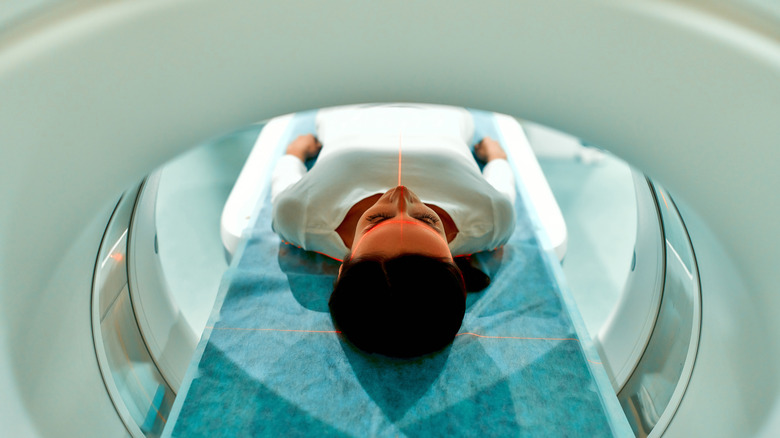The Real-Life Story Of The Girl Living With Only Half A Brain
In 1995, Christina Santhouse was living life as an average 7-year-old girl (via Huffpost). The New Yorker writes that she enjoyed being active and playing sports. Santhouse's life, however, drastically changed after a family vacation to the Jersey Shore. According to ABC News, her foot began twitching nonstop. Santhouse's concerned family took her to a hospital in Philadelphia where they received devastating news: The young girl had Rasmussen's encephalitis.
This autoimmune disease causes half of the brain to become agonizingly inflamed. In Santhouse's case, it was the side of her right brain that had been affected. As the disease is known for causing several seizures a day, she was prescribed anti-seizure medication (per an Associated Press report posted by the Kitsap Sun).
But Santhouse's condition only worsened; more tremors emerged and she began having up to 150 seizures a day. Sometimes they would be so violent that they'd shake her body until she vomited. People reports that despite her condition, she continued to play soccer and participate in extracurricular activities. Knowing that the disease was progressing and was likely going to kill her, a then-8-year-old Santhouse consented to having a hemispherectomy. In other words, half of her brain was going to be removed.
What is Rasmussen's encephalitis?
According to the Texas Children's Hospital, there are only 200-500 known cases worldwide of Rasmussen's encephalitis. Simply put, it's incredibly rare and it's unknown what exactly causes it. Researchers theorize that it results from the immune system attacking healthy body tissue (classifying it as an autoimmune disorder) or that it possibly stems from a virus. MRI's or CT Scans can be used to properly diagnose Rasmussen's encephalitis. Although it can sometimes affect both adults and young adults, a majority of those who contract the disease are under the age of 10, as was Santhouse (via National Institute of Neurological Disorders and Stroke).
For unknown reasons, it only damages one side of the brain (per Cleveland Clinic). Cedars Sinai reports that the symptoms are brutal. As a result of the brain's inflammation, there are frequent seizures, along with mental and physical deterioration. The National Organization for Rare Disorders explains that the muscles can weaken and ultimately cause the loss of motor skills or paralysis on one side of the body.
Furthermore, if the left side of the brain is affected, speech problems can emerge. Eventually, the inflammation can diminish, but not before it causes long-term neurological damage. However, in Santhouse's case, doctors believed that if she did not get half of her inflamed brain removed, she was going to die (via People).
Surgery is the only viable treatment for Rasmussen's encephalitis
As explained by the Texas Children's Hospital, those who receive a diagnosis of Rasmussen's encephalitis have two options; medication and surgery. Cleveland Clinic reports that patients can take anti-seizure medication or steroids. According to Cedars Sinai, however, these do little to help. Santhouse herself was given anti-seizure medication to no avail (via the Associated Press, at the Kitsap Sun). She was told upfront that her best chance at normalcy was getting half of her infected brain removed. Per ABC News, Santhouse's mother, Lynne Santhouse-Catarro, was shocked at this option and stated that "I'd never heard of anything so barbaric."
Although doctors did offer her steroids and chemotherapy, they warned Santhouse that these were only short-term options. Because of the severity of the surgery and the repercussions of it, Catarro refused this course of action at first. In the end, it was Santhouse who made the decision to have half of her brain removed; she could no longer go on having hundreds of seizures a day.
On February 13, 1996, she underwent a hemispherectomy and began her new life with half of a brain (via Huffpost). Santhouse had her 14-hour surgery at John Hopkins and People writes that she was operated on by future presidential candidate Dr. Ben Carson. Despite losing some of her physical mobility on her left side, Santhouse returned to school only nine weeks after her life-changing procedure.
Life with half a brain
As a result of the hemispherectomy, ABC News writes that Santhouse now walks with a limp on her partially paralyzed left leg and suffered peripheral vision loss in the left side of each eye. Furthermore, her left arm is also paralyzed (via The Intelligencer). According to Huffpost, the aftermath of the surgery was rough for Santhouse.
Besides being in pain, she had to adjust to her new disabilities. She was no longer able to play sports and was hindered from other activities. She also had problems with her speech. Ultimately, this caused her to feel isolated from her peers. She was also told it was unlikely she was ever going to drive. Nonetheless, Santhouse was determined to prove doctors wrong. As she put it, "I was full steam ahead" (via People). Eventually, physical therapy allowed Santhouse to regain control of her body.
Having half a brain did not prevent Santhouse from academically excelling, either. In high school, she had a high GPA and became an honor student. She also discovered she loved bowling and became captain of a team that competed in England and Australia. Moreover, Santhouse did end up getting her driver's license at the age of 17. Per The New Yorker, her car had to be customized to accommodate some of her left side's limitations. This included extra side mirrors, a longer rear view mirror, and a knob on the steering wheel. Santhouse also wore prism glasses to make up for her lack of sight.
Christina Santhouse defied all odds
People writes that after high school, Santhouse attended Misericordia University in Pennsylvania. According to YourStory, she knew she wanted a career that was fulfilling but that also made a difference in people's lives. It's why Santhouse decided to become a speech and language pathologist. In five years, she was able to earn her bachelor's and master's degrees. Huffpost reports that after she graduated college, Santhouse took a job at Bucks County Intermediate Unit, a Pennsylvania-based agency that assists public schools. Moreover, she purchased her own home. Santhouse also found love with Vince Paravecchia, a man she met at a church group.
In a 2016 interview with The Intelligencer, Santhouse stated that she was looking for friends when she joined the group. However, she got more than she bargained for as she and Paravecchia quickly hit it off. He has gone on to say that he had no idea that Santhouse was missing half of her brain for months after they began dating. The pair married a few months later and she credited God for bringing them together and for letting her survive Rasmussen's encephalitis.
Christina Santhouse and motherhood
Per The Intelligencer, Santhouse's family never believed she would recover as seamlessly as she did with only half of her brain. They thought they would be lucky if she survived. Instead, Santhouse lived, went to college, and married. Naturally, the next big step for her was motherhood. AP News reports that Santhouse and Paravecchia saw specialists to ensure that pregnancy would not endanger her health. Despite some of her physical limitations, the pair were told that Santhouse was fine to have children. When they found out they were pregnant with their first child, Santhouse proceeded to go to physical therapy to ensure she could properly care for her child.
She gave birth to her first daughter, Madelyn Rose Paravecchia, in June, 2017. Santhouse later had her second child, Amelia Grace, in March, 2019. Both pregnancies were difficult and she had to learn to handle her babies using only one hand. Her occupational therapist later stated that "She has the patience of a saint." A 2006 article from the The New Yorker praised a then-teenage Santhouse for her perseverance. She later told The Intelligencer in 2016 that "I have an amazing life that is not defined by my brain."





